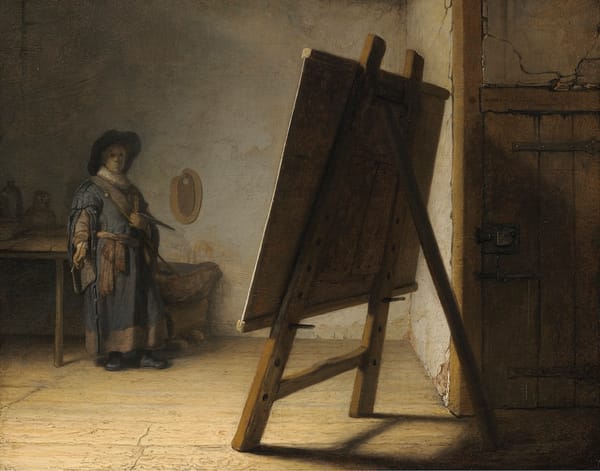Navigating the Gallery System: A Practical Guide for Emerging Artists
Learn how to approach galleries, build your portfolio, and secure exhibitions as an emerging artist. This step-by-step guide offers essential tips for developing professional relationships and growing your artistic career within the gallery ecosystem.

As an emerging artist, understanding and successfully navigating the gallery system can feel like an insurmountable task. Galleries are not just venues for showcasing work; they are gatekeepers to critical networks, collectors, curators and other art professionals. Establishing a relationship with the right gallery can elevate your career, forge valuable connections and provide essential resources. This guide offers practical advice on how to prepare, approach and work with galleries in the UK (and beyond) to build a sustainable artistic practice.
1. Understand the Gallery Landscape
The gallery ecosystem comprises a range of spaces: commercial galleries, artist-run spaces, public institutions, and project rooms. Each type serves a distinct purpose:
- Commercial galleries operate as businesses that sell your work. They often offer marketing, logistical support and access to collectors, but typically take a commission (often between 40–60%).
- Artist-run spaces and co‑ops are usually non‑profit and curated by other artists. These venues can be excellent stepping stones, offering exhibition experience, peer feedback and modest promotion.
- Public institutions (museums, local authority galleries) operate programme-based exhibitions. Securing a show here often requires curatorial interest or external funding and can substantially raise your profile.
- Project rooms are smaller spaces within larger galleries or cultural centres, devoted to experimental work or emerging talent. They provide visibility to new voices without the commercial pressure.
Familiarise yourself with local galleries in your region—whether you are in London, Manchester, Edinburgh or elsewhere. Visit them regularly, sign up for mailing lists and attend openings to gauge the types of artists and work they represent.
2. Build a Strong Professional Portfolio and CV
Your portfolio and CV are the calling cards you will use to approach galleries. They should be concise, visually cohesive and easy to navigate:
- Portfolio: Select 8–12 of your strongest works. Ensure high‑quality photographs or scans, with accurate colour representation. Present them consistently: same background, lighting and layout. Include images of works in situ if relevant (for installation pieces, sculpture or public art).
- Artist statement: Write a brief text (150–200 words) explaining your practice, themes and mediums. Avoid jargon; use clear, engaging language to convey your vision.
- CV: List exhibitions, education, residencies, awards and publications in reverse‑chronological order. Keep it to one or two pages. If you have limited experience, include relevant skills—workshops, collaborations or significant shows in artist‑run spaces.
- Press coverage: If you have any reviews, blog features or social media highlights, include them as links or scanned clippings.
Keep your digital presence in sync with your print portfolio. A well-designed website or PDF that opens and loads quickly gives a professional impression.
3. Research and Target Appropriate Galleries
Rather than sending blanket emails to dozens of galleries, identify those whose programmes align with your practice:
- Compile a shortlist: Note galleries representing artists whose work shares conceptual or aesthetic affinities with yours.
- Study past exhibitions: Read press releases, reviews and view online archives. Consider which shows resonated with you and why.
- Assess gallery scale: Smaller galleries can offer more personal attention but have limited resources. Mid‑sized galleries or branches of international galleries often balance support with flexibility.
- Check submission protocols: Many galleries outline open call procedures on their website; some accept unsolicited proposals only at certain times of year.
4. Approach Galleries Professionally
Your initial contact should be concise, personalised and respectful of the curator’s time:
- Email subject line: Use a clear title, for example: “Portfolio Submission: [Your Name]—Painting/Photography.”
- Introduction: Address the director or curator by name. Briefly explain why you are contacting them (e.g. you admire their programme and believe your work complements it).
- Attach: A one‑page CV, artist statement and a low‑resolution PDF portfolio (no more than 5MB). Alternatively, provide a link to a password‑protected online portfolio.
- Closing: Offer to send further materials or meet for a studio visit. Thank them for their consideration.
Avoid mass‑mailings or impersonal forms. Curators receive hundreds of submissions; a thoughtful, concise email stands out.
5. Embrace Group Exhibitions and Open Calls
Participating in group shows, competitions and open calls offers multiple benefits:
- Exposure: Your work will be seen by new audiences, including curators and collectors.
- Experience: You learn exhibition etiquette, installation techniques and gain confidence presenting your practice publicly.
- Networking: Fellow artists, curators and visitors can lead to future opportunities.
Monitor platforms such as the Artist Newsletter, ArtRabbit and Open Call Art UK for opportunities. Tailor each application to the theme, providing only the required materials and following guidelines closely.
6. Network and Build Relationships
Galleries often discover new talent through personal recommendations and word of mouth. Cultivating genuine relationships can open doors:
- Studio visits: Invite gallery contacts to your studio. Show them new work before it’s exhibited. Prepare a brief walk‑through, highlighting your process and ideas.
- Art fairs and events: Attend regional and international fairs (e.g. Frieze London, London Art Fair, Manchester Contemporary). Dress professionally, carry business cards and engage in meaningful conversations.
- Social media: Use platforms like Instagram thoughtfully. Post high‑quality images, behind‑the‑scenes content and updates on exhibitions or residencies. Tag galleries sparingly and only when relevant.
- Professional bodies: Join organisations such as The Artists Information Company, Contemporary Visual Arts Network (CVAN) or your local art guild. Workshops and seminars foster connections in quieter settings.
7. Leverage Online Galleries and Digital Platforms
Digital spaces can complement traditional gallery representation:
- Online galleries (e.g. Saatchi Art, Artfinder) provide access to global audiences. They often handle shipping and transactions but charge commission fees.
- Artist-run websites: Curate your own online exhibitions or collaborate with peers to build a digital presence.
- Virtual art fairs: Many fairs now run virtual editions. Apply with the same professionalism as you would for physical events, ensuring digital files meet technical specifications.
While online platforms can boost sales and visibility, they should supplement—rather than replace—physical gallery engagement.
8. Preparing for Your First Solo Show
Securing a solo show is a significant milestone. When it happens, preparation is key:
- Negotiation: Discuss exhibition dates, budget, insurance, installation costs and publicity support. Clarify whether the gallery will provide a catalogue or printed materials.
- Selection: Choose a coherent body of work. Consider the spatial constraints and flow of the gallery space.
- Installation planning: Visit the gallery in advance to measure walls, note lighting and plan layouts. Provide a hanging plan and work dimensions if required.
- Marketing: Collaborate on invitations, press releases and launch events. Offer to write copy, provide images and coordinate with local press or bloggers.
- Opening event: Prepare a short talk or artist’s introduction. Engage visitors in conversation but also enjoy the moment—it’s your achievement.
9. Maintain Relationships and Plan for Growth
Your relationship with a gallery is ongoing. After your show:
- Follow up: Send a thank‑you note, share any press coverage and discuss potential next steps—be it a future show or participation in art fairs.
- Stay in touch: Keep your gallery updated on new projects, awards or residencies. Quarterly newsletters or informal coffee meet‑ups can sustain the connection.
- Expand your network: As you grow, seek new galleries in other cities or countries. Adapt your approach to different markets, considering cultural nuances and collector behaviour.
Conclusion
Navigating the gallery system requires persistence, professionalism and strategic planning. By understanding the types of galleries, honing your portfolio, targeting the right venues, and cultivating genuine relationships, you can steadily build a gallery network that supports your practice. Remember that every interaction—whether an open call application or a studio visit—contributes to your reputation. Stay resilient, keep refining your practice, and celebrate each milestone along the way. With dedication and thoughtful engagement, the gallery world will become a navigable and rewarding space for your art career.





